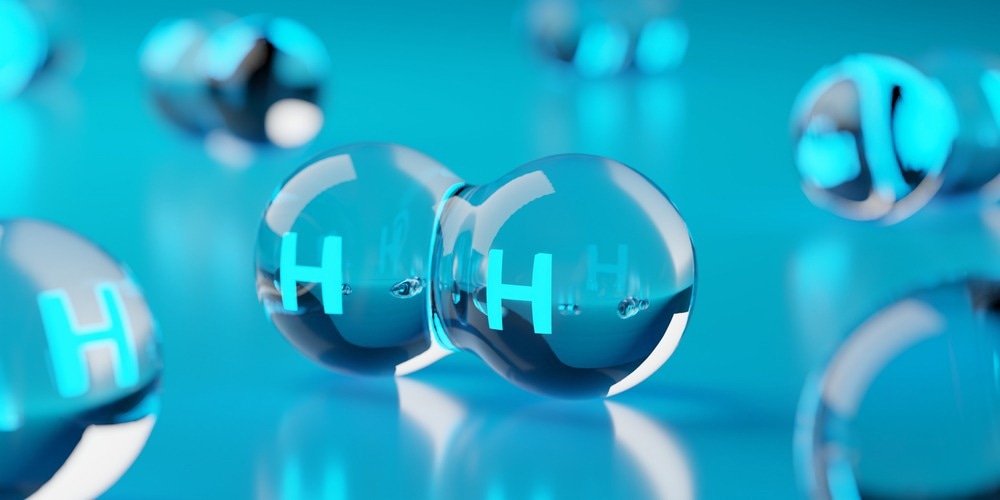A pre-proof paper from the journal Applied Surface Science offers a fresh perspective on synthesizing a two-dimensional photocatalyst by altering the localization of graphite carbon nitride's electron cloud density and breaking topological symmetry. This enhances the rate of photocatalytic hydrogen evolution.

Study: Electron Cloud Density Localized Graphitic Carbon Nitride with Enhanced Optical Absorption and Carrier Separation towards Photocatalytic Hydrogen Evolution. Image Credit: Shawn Hempel/Shutterstock.com
Photocatalytic hydrogen evolution is hampered by high photogenerated carrier recombination and low visible light sensitivity in symmetrical graphitic carbon nitride (CN). In an upcoming paper, researchers have designed a unique carbon nitride (DPCN) containing an asymmetrically embedded pyridine ring.
By modulating the location of the electronic structure, the embedded Pyridine Ring increases separation efficiency and shortens the bandgap, enhancing the photocatalytic hydrogen evolution rate.
What is the Significance of Photocatalytic Hydrogen Evolution?
The extensive use of fossil fuels has significantly contaminated the environment, necessitating green and renewable energy sources. Since hydrogen has a high energy density and produces no secondary pollutants, it is one of the most promising clean fuels on the market today.
However, several problems must be resolved before the world can deal with a new energy situation. The most important of these is establishing an effective H2 manufacturing method that satisfies industrial demands.
Such a system must consider a sustainable source of H2 and environmental considerations such as minimizing or removing waste products, with special emphasis on CO2 or other greenhouse gases (GHG).
Among these methods, the photocatalytic synthesis of H2 from water splitting has attracted considerable interest due to its low cost, low energy consumption, and environmental friendliness. It involves the conversion of solar into chemical energy utilizing an appropriate photocatalyst.
In recent years, significant progress has been achieved in developing semiconductors for photocatalytic hydrogen evolution. Creating a photocatalyst with a broader light absorption spectrum and effective carrier transport is essential to attain high photocatalytic hydrogen evolution performance.
In this regard, graphitic carbon nitride has been widely investigated as a photocatalyst due to its simple manufacture, suitable band structure, high chemical stability, and two-dimensional nanosheet microstructure. However, in its purest form, graphitic CN photocatalyst has a weak reactivity to visible light and a delayed transfer and separation of photogenerated carriers.
Limitations of Past Photocatalytic Hydrogen Evolution Rate Research
Enhancing the photocatalytic hydrogen evolution rate has been a significant focus of past research. These include morphological modulation, hetero junction creation, and element doping. These methods improve the efficacy of photocatalytic hydrogen evolution.
However, due to these techniques, graphite carbon nitride has never retained its two-dimensional properties.
Using Graphite Carbon Nitride with Embedded Pyridine Ring
Constructing graphite CN photocatalyst with organic molecular rings embedded in the graphite could be a promising way to produce a high-performance photocatalyst.
This study proposes a molecular ring embedded in graphite carbon nitride which could disrupt its electron symmetry while preserving its two-dimensional crystallization structure.
The researchers designed a graphite CN photocatalyst with an embedded pyridine ring (DPCN) by replacing one heterocyclic ring in the fundamental graphite CN structural unit with a pyridine ring.
Transmission electron microscopy (TEM) and scanning electron microscopy (SEM) techniques helped study the morphology and microstructure of as-prepared catalysts.
Ultraviolet-visible (UV-vis) diffuse reflectance spectra (DRS) were used to evaluate the light absorption and bandgap of the study under observation.
Important Findings of the Study
The pyridine ring's embeddedness considerably improves the photocatalytic hydrogen evolution, which favors visible light's absorption and the carriers' efficient movement. These are further supported by femtosecond transient absorption (fs-TA) spectroscopy and UV-vis spectra, which agree with DFT theoretical simulations.
In a visible light irradiation test ( > 420 nm), the DPCN shows an improved photocatalytic hydrogen evolution rate of 180.5 μmol h-1, which is 6.3 times greater than the 28.5 μmol h-1 rate of pristine carbon nitride.
At wavelengths of 420, 450, 500, and 550 nm, the apparent quantum efficiency (AQY) of DPCN-20 is estimated to be 14.6%, 6.2%, 0.4%, and 0.3%, respectively.
Cycling tests demonstrate the greater stability of DPCN-20. It performs better than most g-C3N4-based photocatalysts, further supported by XRD patterns, TEM characterizations, and FT-IR analysis.
The evaluation of hydrophilicity, pore structures and specific surface area demonstrates that they are not the primary determinants of improved photocatalytic hydrogen development. The optimization tests demonstrate that the highest photocatalytic hydrogen evolution rate can be achieved with a 3% Pt loading level on DPCN-20. When the catalyst dose is 40 mg, photocatalytic hydrogen evolution rates are the best.
This research has improved the rate of photocatalytic hydrogen evolution by changing the electron cloud density and opening up new avenues for future advancements.
Reference
X. Ruan, Z. Wang, Z. Wei, H. Zhang, L. Zhang, X. Zhao, D.J. Singh, J. Zhao, X. Cui, W. Zheng. (2022) Electron Cloud Density Localized Graphitic Carbon Nitride with Enhanced Optical Absorption and Carrier Separation towards Photocatalytic Hydrogen Evolution, Applied Surface Science. https://www.sciencedirect.com/science/article/abs/pii/S0169433222018281
Disclaimer: The views expressed here are those of the author expressed in their private capacity and do not necessarily represent the views of AZoM.com Limited T/A AZoNetwork the owner and operator of this website. This disclaimer forms part of the Terms and conditions of use of this website.